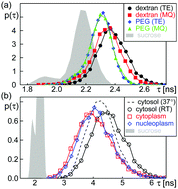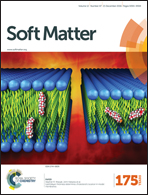Abstract
Cellular fluids are complex media that are crowded with macromolecules and membrane-enclosed organelles on several length scales. Many studies have shown that crowding can significantly alter transport and reaction kinetics in biological but also in bio-mimetic fluids. Yet, experimental insights on how well bio-mimetic fluids can capture the complexity of cellular fluids are virtually missing. Therefore, we have combined fluorescence correlation spectroscopy (FCS) and fluorescence lifetime imaging microscopy (FLIM) to compare the spatial heterogeneities of biological and simple bio-mimetic crowded fluids. As a result, we find that these artificial fluids are capable of mimicking the average diffusion behavior but not the considerable heterogeneity of cellular fluids on the mesoscale (∼100 nm). On the nanoscale, not even the average properties are captured. Thus, cellular fluids feature a distinct, heterogeneous crowding state that differs from simple bio-mimetic fluids.


 Please wait while we load your content...
Please wait while we load your content...